 |
| Yours truly in Yiwu, April 2011 |
The township of Yiwu is 120km to the east of Jinghong. A modern highway cuts through Jinuo mountain and makes the journey to the base of the Yiwu mountain range short & direct. But once one leaves the highway, it’s a different story. The road narrows to two lanes, climbing through young banana & rubber tree plantations. With no bridges to cut across valleys, the ascent to 1700m is one long and winding road full of hairpin turns & spectacular views. Reflecting Yiwu’s importance in the tea trade, the road is at least paved all the way, not like the potholed sandy tracks leading up to other famous tea villages. Yet with a steep drop off on one side, no guardrail, lane markers or street lights, it is a journey to be made in the daytime, preferably with a driver who knows every bend & makes good use of their horn on those blind corners!
 |
| Miao people selling fruit on the road to Yiwu |
We stopped to buy some fruit from these impoverished people from the animist Miao tribe, who had been relocated from Yuxi in Jinuo mountain, to look after the banana trees. The trees & land don’t belong to them, and they live on an incredibly steep slope like mountain goats. Despite their hardships, they generously tried to give us a lot more fruit than what we had paid for!
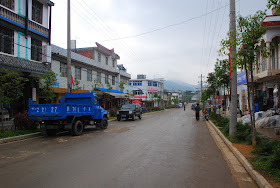 |
| Yiwu town's main road |
The modern township of Yiwu is a simple affair, with a few unremarkable two and three storey shop-houses, built around one main road. We arrived just before lunch, but the restaurant staff were all busy making maocha. It seems during the peak production period in early Spring, it’s all hands on deck to make the most of good weather. We sampled some of their tea, but the tea smelt off, and picking through their maocha, we found a lot of burnt leaves. They were also using a machine to “rou nian” the tea (bruise & roll the fried leaves after wok frying), not a good sign in a village famous for its hand made gu shu.
 |
| View of old Yiwu village from across the valley |
 |
| Yiwu primary & middle school |
 |
| School girls watching the boys play basketball |
The more charming, ancient village of Yiwu is located on a nearby hilltop, just below the local primary & middle school which sits atop the crest of the hill. There is no senior high school here, kids that want further education have to be sent to Jinghong. When we arrived at lunch time, the school kids were playing basketball & dodgeball in the quadrangle. An old woman sat beside a cobblestone lane, picking huang pian out of a tray of maocha.
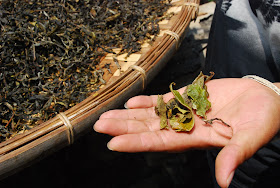 |
| Picking out Huang Pian (older yellow leaves) |
 |
| Stone steles in the Yiwu tea museum |
Adjacent to the school playground is the town museum, basically two small rooms filled with dusty ancient stone steles, recording the town’s history as an early puer trading center. Han chinese traders first arrived in Yiwu in the 17th century with an imperial decree to collect & export tea from the surrounding 6 famous mountains. The stone steles record production quotas and tax levies, as well as the family names of the early settlers. Unfortunately during the cultural revolution, many of these were deliberately broken up and buried, to avoid retribution from red guards hunting for rich land owners.
 |
| Chickens everywhere |
Many of the town’s people are descendent from those original founding families. They still produce puer today. Trays of maocha lay drying outside their front door, propped up on bamboo poles. Mother hens and their brood of chicks pecked and scuttled about underneath. I caught one rooster crowing & preening himself on top of one tray of maocha, and couldn’t help wondering if the close proximity with animals leads to the occasional “surprise” in the final product.
 |
| Now that's what I call You Ji Cha! |
Being built on a hill side, Yiwu offers a great view of the surrounding tea fields. Cobble stone tracks wind between village buildings sunbaked & cracked with age. We peeked inside an old house and were invited to take a look around. Upstairs in the attic, old farming implements and household items were arranged on a bench. Two puer bings were drying on the windowsill. The proud house owner explained her family had been living here for hundreds of years. Truly, a house built on tea.


We stopped in at a guesthouse and asked the owner if she’d take us to see her family’s tea trees. Her elderly father sat on the stoop, with a huge disfiguring scar right across his eye. He told us a bear in the forest mauled him, many decades ago. With the sun about to set, we took off at a brisk pace, crossing the valley to where tea bushes grow 1m high, in rough, straggly rows, interspersed with other tree species. Our guide Ah-Hong pointed out many edible wild fruit & flowers that grew there, and we had a great time picking fruit as well as tea. Large camphor trees rose up above the tea bushes, a natural deterrent against insects, although some say their presence naturally scents the tea too. Also hidden in the tea garden are ancestral tombs, evidence of the close relationship between the tea farmers and their trees.
 |
| The spring flush |
 |
| Lichen covered branches |
Some of the bushes were growing from thick stumps about 15cm wide, and the branches appeared to have been heavily pruned, keeping the bushes around 1-1.5m tall. I heard this tea is still sometimes sold as “da shu" (big tree or arbor tea), as the stumps are over a hundred years old. Nearby, some stumps showed no sign of regrowth and appeared to have died. Our guide explained when a tree gets sick or damaged, they sometimes cut them back to give them a chance to regrow. Another explanation is the farmers deliberately cut back the old trees, to make them easier to harvest and to encourage them to grow faster & produce more leaves.
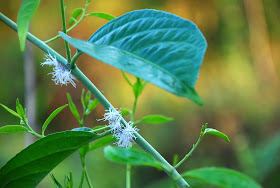 |
| Aphids disguised as caterpillars |
The tea trees were covered in lichen, and we spotted an abundance of hairy white aphids gathered on one plant, a good sign that pesticides & herbicides are not used here. The aphids gather together to disguise themselves as caterpillars, but they jump in all directions when touched.
 |
| Tea pickers returning from a hard days work |
It was a fantastic afternoon. As we made our way back to the village, young kids in muddy clothes fought a mock gun battle with sticks. Village dogs ran past us, busy on their own secret mission. We were over taken by a sprightly group of tea pickers, their legs covered in blue binding to prevent insect bites & scratches, their cane baskets brimming with the day’s harvest.
 |
| After wok frying, comes "Rou Nian" (knead & roll) |
 |
| Warm & sticky leaves |
Back in the village, we watched local women wither, fry & roll the fresh leaves. It takes 4 kgs of fresh leaves (sometimes 4.3kg if it's rained) to make 1 kg of maocha, and the leaves have to be withered first to make them a little sticky & prevent them from shredding during the sha qing (wok frying) process. After being prevented from photographing the “state secrets” of Menghai, it was refreshing to see first hand how the villagers grow & harvest tea, then produce the maocha. For our first day in Yiwu, we could not have asked for more.
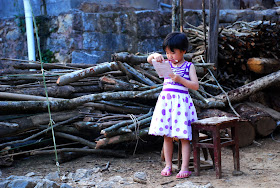 |
| Farmers daughter doing her homework |
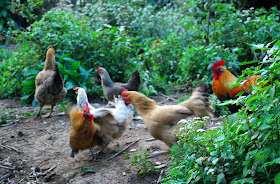 |
| Chickens fighting |












No comments:
Post a Comment